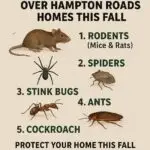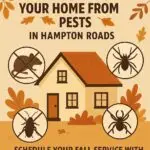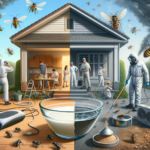20 COMMON PESTS IN PORTSMOUTH, VIRGINIA

1. ANTS
Description: Ants are social insects with segmented bodies and elbowed antennae. Common types in Virginia include carpenter ants, pavement ants, and odorous house ants.
Habitat: Found both indoors and outdoors. Carpenter ants nest in wood, while others build nests in soil, under rocks, or inside structures.
Prevention: Keep food sealed, clean up spills immediately, and seal entry points. Regular inspections and treatments can help control ant populations.

2. BED BUGS
Description: Small, reddish-brown insects that feed on blood. They are about the size of an apple seed and can leave itchy bite marks.
Habitat: Often found in mattresses, box springs, bed frames, and furniture. They can also hide in cracks and crevices in walls and floors.
Prevention: Regularly inspect bedding and furniture, use protective covers on mattresses and box springs, and reduce clutter to limit hiding spots.

3. COCKROACHES
Description: Resilient insects known for their flat, oval-shaped bodies and long antennae. Common species include the German cockroach, American cockroach, and Oriental cockroach.
Habitat: Thrive in warm, moist environments, commonly found in kitchens, bathrooms, and basements.
Prevention: Keep areas clean and dry, store food in sealed containers, and eliminate hiding places by sealing cracks and crevices.

4. FLEAS
Description: Small, wingless insects with powerful legs for jumping. They feed on the blood of mammals and birds, often causing itchy bites.
Habitat: Commonly found on pets and in areas where pets sleep or rest, such as carpets, bedding, and upholstery.
Prevention: Regularly groom and treat pets for fleas, vacuum frequently, and wash pet bedding in hot water.

5. MOSQUITOES
Description: Slender, long-legged insects known for their biting habits. Female mosquitoes feed on blood to produce eggs.
Habitat: Breed in standing water, often found near ponds, marshes, and containers holding water.
Prevention: Eliminate standing water, use insect repellent, and install screens on windows and doors.

6. RODENTS
Description: Common rodents include house mice, Norway rats, and roof rats. They have long tails and sharp teeth and are known for gnawing.
Habitat: Found in homes, garages, and sheds, often nesting in walls, attics, and basements.
Prevention: Seal entry points, store food in airtight containers, and keep your home clean and clutter-free.

7. SPIDERS
Description: Arachnids with eight legs and two body segments. Some, like the black widow and brown recluse, can be dangerous.
Habitat: Often found in dark, undisturbed areas such as basements, attics, and closets. Also found outdoors in gardens and under rocks.
Prevention: Reduce clutter, seal cracks and gaps, and remove webs regularly.

8. STINGING INSECTS
Description: Includes bees, wasps, hornets, and yellow jackets, identifiable by their ability to sting.
Habitat: Build nests in trees, eaves, attics, and underground. Can be aggressive when disturbed.
Prevention: Avoid wearing strong fragrances, keep food covered outdoors, and seal potential nesting sites.

9. TERMITES
Description: Small, pale insects that feed on wood and can cause significant structural damage. Often mistaken for ants but have straight antennae and a uniform waist.
Habitat: Live in colonies, commonly found in wood structures, soil, and mulch.
Prevention: Reduce wood-to-soil contact, fix leaks promptly, and schedule regular termite inspections.

10. SILVERFISH
Description: Small, wingless insects with a silvery, metallic appearance and a fish-like shape. Known for their quick, darting movements.
Habitat: Prefer dark, damp areas such as basements, bathrooms, and kitchens.
Prevention: Reduce humidity, seal cracks and crevices, and store dry foods in airtight containers.

11. EARWIGS
Description: Elongated insects with pincers at the rear end. They are generally dark brown to black.
Habitat: Moist, dark environments such as under rocks, mulch, and in basements.
Prevention: Reduce moisture, remove debris and organic material, and seal entry points.

12. CRICKETS
Description: Insects known for their chirping sound. They have long antennae and powerful hind legs for jumping.
Habitat: Found in basements, crawl spaces, and around foundations.
Prevention: Reduce moisture, seal cracks and crevices, and keep outdoor lights off to avoid attracting them.

13. STINK BUGS
Description: Shield-shaped insects that release a foul odor when disturbed. Typically brown or green.
Habitat: Commonly found on plants and can enter homes seeking warmth.
Prevention: Seal entry points, remove food sources, and use screens on windows and doors.

14. TICKS
Description: Small arachnids that feed on the blood of mammals, birds, and reptiles. Known for transmitting diseases like Lyme disease.
Habitat: Grassy, wooded areas and on pets.
Prevention: Wear protective clothing outdoors, use tick repellents, and check pets and people for ticks regularly.

15. CENTIPEDES
Description: Long, segmented bodies with one pair of legs per segment. They are fast-moving and can bite.
Habitat: Moist environments such as basements, bathrooms, and under rocks.
Prevention: Reduce moisture, seal entry points, and remove debris.
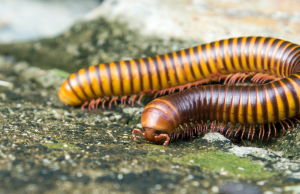
16. MILLIPEDES
Description: Similar to centipedes but with two pairs of legs per segment. They are slower and do not bite.
Habitat: Prefer damp, dark places such as under rocks, mulch, and in basements.
Prevention: Reduce moisture, seal entry points, and remove organic debris.

17. GNATS
Description: Small, flying insects often found around decaying organic matter. They can be a nuisance indoors.
Habitat: Damp, organic-rich environments such as overwatered plants, trash cans, and drains.
Prevention: Reduce moisture, remove decaying organic matter, and ensure good ventilation.

18. MOTHS
Description: Winged insects that can cause damage to clothing and stored food products. Common types include clothes moths and pantry moths.
Habitat: Found in closets, pantries, and storage areas.
Prevention: Store clothing and food in airtight containers, regularly clean storage areas, and use moth repellents.
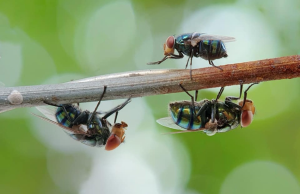
19. HOUSE FLIES
Description: Common flies known for spreading disease. They have large red eyes and transparent wings.
Habitat: Found around garbage, decaying matter, and food sources.
Prevention: Keep areas clean, use fly screens, and properly dispose of waste.

20. CARPENTER BEES
Description: Large, solitary bees that bore into wood to create nests. They are similar in appearance to bumblebees but have a shiny abdomen.
Habitat: Nest in untreated or weathered wood, such as decks, eaves, and fences.
Prevention: Paint or treat wood surfaces, fill existing holes, and use bee deterrents.
NEED PROFESSIONAL PEST CONTROL?
At Adibug, we offer a variety of pest control plans tailored to your specific needs. Whether you’re dealing with a one-time pest issue or need year-round protection, our expert team is here to help you choose the best plan for your home.
Website: Adibug.com
Phone number: 7578520085




